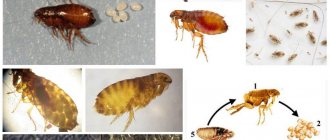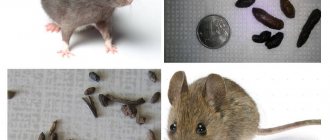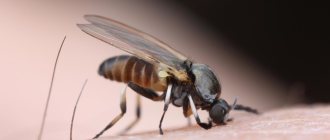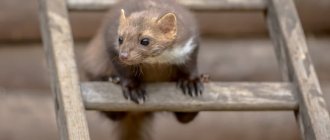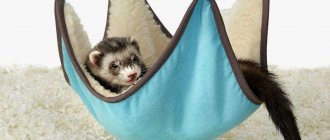A simple and humane trap can be easily and simply made with your own hands:
- You need to take a cage, box or bucket and attach a door to it that would slam shut when the spacer is knocked down.
- Bait is placed inside (for example, a dead chicken, a piece of lamb or pork);
- Sensing the smell of raw meat, the predator will reach for the bait and will definitely fall into the trap.
However, a person must be nearby at this moment so that the animal cannot knock down the door, because it will fight to the last for its life and freedom. It is recommended that the caught animal be taken out and released in the forest, away from human habitations.
Using this method, you should not put poisoned bait in the trap.
, because pets (cats, dogs) will definitely want to try what’s hidden there.
In addition, it is worth considering one point: it is imperative to destroy your scent on traps or traps, otherwise the animal will not even approach the devices. You can do this in several ways:
- smear traps and traps with manure;
- whiten with slaked lime;
- boil a trap or trap in spruce needles.
Pets
Man's four-legged friends can be excellent helpers in preventing predators from entering the chicken coop. The dog needs to be placed on a long chain so that he can reach all corners of the chicken coop, or be given free range in the yard.
If you plan to use cats, then you need to “send” them directly into the chicken coop. But you shouldn’t do this with dogs, because being locked in a room, the dog begins to be afraid and sad and can get enormous stress.
If unexpected guests enter, cats and dogs will definitely notify you of this with their behavior and, in addition, they will be able to scare away small predators with their presence.
Traditional methods
Among the folk methods that should be used to protect the chicken coop against small predators, one can name. It consists in the fact that the walls of the building need to be coated with tar. However, the effectiveness of this method is very questionable, because the animal can climb through the roof or dig under the foundation. So the statement that the hunter will be caught in a sticky trap is very controversial. But, on the other hand, an unpleasant smell can scare away the animal.
Using repellers
Ultrasonic repellers are a popular method of pest control in the home - they are used against insects, rats and mice. A similar control scheme is also suitable for small predators - upon sensing low-frequency signals, the animal will leave the house in panic. However, as reviews show, not all models of such devices are effective, so you need to approach the issue of choice seriously - read what users say on the Internet, look at reviews, compare prices, and choose the best for yourself.
An alternative to this method is to install a light with a motion sensor near the chicken coop. When a predator approaches the hunting area, the lamps turn on and the device emits sound and light signals that will scare the animal.
Mechanical methods
If you prefer humane methods of pest control, you can try to catch the animal with your bare hands, although this will be quite difficult. Weasels, ferrets and martens operate under the cover of darkness, so it can only be caught at night. But how to catch an animal so that it does not harm you? There are two ways to do this.
Chicken owners are familiar firsthand with a small but dangerous animal - a weasel, which can raid a chicken coop, mercilessly exterminating its inhabitants. Today we will talk about methods to neutralize such an uninvited guest and secure the poultry house.
Ferret and weasel - one family
The weasel, like the ferret, belongs to the weasel family. History is silent about why this small, bloodthirsty and ferocious predator was named so affectionately. Among its relatives, the weasel is the smallest predator.
Males grow to a maximum of 26 cm, and their weight is approximately 250 g. Females are much smaller: body length ranges from 11 to 22 cm, and weight from 30 to 100 g. Their tails also differ in size. In a male, the length of the tail can be approximately 8 cm, and in a female - 6.5 cm. The weasel's method of movement is jumping up to 30 cm long.
Externally, the weasel looks like a ferret and has reddish-brown fur. Only on the neck and belly the fur is white. In the cold season, the dark color of the fur changes to white with long pile. Thanks to this white color, the weasel becomes invisible in the snow.
The weasel's sharp claws on strong short legs make it possible to excellently climb trees. With her claws she can very quickly tear apart mouse holes.
Weasels do not have a permanent shelter. She rests in secluded places. It can be:
- Thickets of bushes.
- Spaces among the roots.
- Rock crevices.
Weasels are also found in the tundra and steppe. In the article you can see what a ferret and weasel look like; the photos show an already mature animal.
The weasel chooses a place to live where there is a lot of food. The basis of nutrition is voles. Although she can make changes to her diet. Treat yourself to bird eggs, lizards, fish, large rodents, rabbits, snakes and even insects.
What does the little predator eat?
The black ferret prefers to feast on mice. The main diet consists of voles and mice, water rats, frogs and toads, large insects and wild birds. If they find hare holes, they will definitely sneak in and strangle the little bunnies. If the ferret's home is located next to a person, then it calmly attacks poultry and rabbits. Many people are interested in what a ferret looks like and what this predator eats.
Their behavior is quite aggressive. They are ready to offer resistance to large animals at any moment. Thanks to its agility, the predator can catch prey on the run, but it can also wait for its prey near the hole for a long time. With the onset of darkness, the ferret goes hunting.
Haystacks, rotten stumps, heaps of dead wood can serve as shelter for it, and sometimes it can occupy a fox or badger hole.
Manners of affection
The weasel is the ferret's closest relative. In the old days, there was a belief that meeting a beautiful predator would bring bad luck. The weasel is not at all afraid of people; it can easily steal something from food, and do it suddenly and completely unnoticed by a person.
At the same time, there was another opinion, completely opposite to the first. Its meaning was that affection can bring good luck and happiness. The weasel brings great benefit to humans because in a short time it can destroy a large number of rodents that cause significant harm to agriculture. The weasel looks like a ferret and its manners are no different from representatives of this species.
The weasel tries to go hunting at night. Its long, stately body makes it possible to easily penetrate mouse holes, and its sharp claws easily deal with prey. During the daytime, the weasel is also active. During the day, she runs about a kilometer in search of food. In winter, the weasel moves under thick snow. Rodents have no escape from it, neither underground nor on the ground.
The caring weasel loves to stockpile supplies in case of famine; the animal stores mouse carcasses in a hidden place. The area where the weasel hunts depends on the number of inhabitants. If the “food” runs around in sufficient quantities, the weasel remains in this place for a long time. As soon as there is less prey, it moves to other places.
This tiny predator treats people without fear, but also without friendliness; in fact, it is not tamed.
Ferret instead of a cat
The domesticated form of the wild forest ferret is called the ferret or furo. About 800 years ago, the first domestic ferrets appeared. They lived only with people of the upper class.
Today, the albino ferret is becoming the most popular among breeders. This is a descendant of black forest polecats, and it is he who is called furo. He has a snow-white coat and differs from his relatives in his red eyes. What does a ferret look like? The photo in the article shows furo in all its glory.
Furos kept at home are quite large: body length can reach 50 cm, weight 2 kg. The lifespan of a domestic ferret is significantly longer than that of its wild counterparts. When organizing feeding a ferret, you need to take into account that it is a predator. The diet should include chicken, duck, and fish. They will not refuse cod, haddock and flounder.
The forest ferret is also called the common or dark ferret. As noted above, the ferret is a real predator. These sneaks take great pleasure in eating rats and mice, and in addition dangerous vipers.
It has been established that snake bites do not harm animals in any way. In order to eat nourishingly and well, the ferret is forced to hunt for a living, showing cunning, endurance and dexterity.
Forest ferret: description
Black or dark ferrets are naturally crossed, and the result is predators of various colors. An adult ferret looks like its relatives, only on the back it has a black-brown color. The rest of the body is almost black. Sometimes you can find red or white animals.
Forest ferrets have very long, sharp claws. The elongated body of the male reaches a length of up to 50 cm, and the tail - up to 17 cm. The body weight of the male reaches 1,500 g. The female is much smaller, her weight often does not exceed 800 g, and her body length is approximately 40 cm. The tail of females is naturally shorter than that of the male.
The face mask is the calling card of the ferret. Externally, it differs from other species. The mask has a characteristic contrasting ornament, with it the forest polecat looks like a decorative animal.
What is a weasel?
With a long tubular body and long tail, the weasel is a wild and often solitary animal compared to the ferret. It has a slender body that often comes to life when hunting its prey in small holes. Typically, the weasel's body size ranges from 6.8 to 8.5 inches. It has a long tail, which also gives it balance when hunting its target prey. Females are smaller than males.
In appearance, the weasel has a red-brown coat with a white underbelly coat. The picture below shows the difference between these animals.
The weasel rarely becomes a pet due to its aggressiveness, even to people. It is known to prey on birds, so many homeowners rarely consider it a pet. Weasels hunt snakes, birds, mice, rats and rabbits. He can even kill for a trophy, as most of his kills go empty. Unlike the ferret, the weasel is not a nocturnal animal. He sleeps at night and hunts during the day. In addition, weasels are rarely in groups, as they often fight.
There are 17 species in the Mustelidae family and weasels belong to 10 of the 17 species. Ferrets, on the other hand, are a subspecies of the ferret division Mustelidae. Both of these animals have thick fur and a thin body. Hunting habits, characteristics and appearance vary.
What do black-footed ferrets like to eat?
These cute predators love to eat prairie dogs. But it also happens that they have to eat gophers and mice. A ferret needs 50-70 g of meat per day. These predators do not store food.
This ferret prefers a solitary existence, with the exception of the breeding season.
The ferret (Mustela putorius) lives in Eurasia. The so-called African ferret is apparently an albino form of the black one. It freely interbreeds with the forest ferret and is not an independent zoological species. The black ferret is found in almost all of Western Europe, including England, and in a large territory of the European part of Russia, except for North Karelia, north-east of Crimea, the Caucasus, and the Lower Volga region. Over the past decades, the black ferret has been intensively spreading to the north - in Finland. Black ferrets do not exceed 48 cm in length, 17 cm in tail, and 1.5 kg in weight. The black ferret's main diet consists of voles and mice. In addition, the black ferret often catches frogs, toads, partly wild and domestic birds, and sometimes rabbits.
The weasel and ferret are some of the most confusing animals if they don't look closely. It appears to be a cousin of the other one, which has long tubular bodies, albeit in different dimensions. They belong to the scientific parent name Mustelidae. However, there are significant differences between these types, as this article elaborates as follows.
Signs of a predator appearing in a poultry house
Ferrets are very dangerous to chickens
The peculiarity of the ferret is that, having entered the poultry house and seeing an abundance of food, the animal can destroy all the chickens in one night, although it is not able to eat so much prey.
This feature of the animal is especially harmful. In the excitement, a marten or polecat can kill even large birds - geese, turkeys. There are signs that make it possible to determine the presence of a predator near the poultry house before the first victims appear.
The animal’s attempts to enter the chicken coop are evidenced by the following:
- Chickens do not leave their roosts in the morning - the frightened bird sits on top, even when the owner comes in and pours out food. This behavior occurs when a predator is near the house.
- Chickens huddle on the highest perches and even in very crowded conditions refuse to sit lower.
- Poultry screams in the chicken coop at night - when they hear a ferret trying to get inside, the chickens wake up, start screaming, and make a long noise. When the owner appears, the bird does not calm down.
If a predatory animal has entered the chicken coop, signs of hunting become obvious. All or some of the chickens are killed. The bird's blood is drunk, its legs and head are often chewed off.
When there is a suspicion that a ferret has appeared near the chicken coop, immediate action must be taken. The very next night the bird can be completely destroyed. A trap is immediately placed on the predator, and the bird is transferred to a safe place, inaccessible to the uninvited guest.
Attention! When the ferret has completely destroyed the chickens, it makes no sense to get the bird again (until the hunter gets rid of it): the pest will kill new pets.
How to understand that “thieves” are visiting you
Changes in chicken behavior
Ferrets, martens, and weasels visit poultry houses at night or at dawn. Therefore, it is difficult to catch them at the crime scene.
Predators do not always attack immediately. Often they first reconnoiter the situation. And at first you will not find obvious signs of their presence in the form of dead chickens.
You should be wary if you go into the chicken coop in the morning, and the birds are sitting on a perch or in nests and are not in a hurry to eat. This means that a ferret, marten or weasel definitely visited them at night.
The chickens are scared and worried. And they try to protect themselves and the masonry
And in order not to attract the attention of predators, they do not make a sound
True signs
If you don't take action, you will soon find a chicken with its head chewed off. This is exactly what predators do.
The ferret does not eat the head, only chews it off. But it leaves the carcasses in such a state that they cannot be used later in cooking. The marten prefers to steal chickens rather than eat on the spot.
Broken eggs are also a sign of uninvited guests. If you find that the contents of the testicles have been eaten, and the chickens are fine, most likely small rodents were operating in the poultry house. They are described in detail in the article “How to get rid of rats in a chicken coop.”
To understand who is strangling the chickens, measure the distance between the tracks of the animal: 40-45 cm - ferret, 20 cm - weasel, 30-35 cm - marten.
Animal habits
Neither a ferret nor a weasel will limit itself to one bird. If an animal has strangled a chicken at least once, it will visit the farm until it kills all the chickens, ducks and even geese.
Moreover, predators will remember the place. And if you start a new livestock, they will come again. Therefore, you need to know how to catch a weasel, ferret or marten. And not just drive away.
Animals get into the chicken coop by digging. Then they catch the bird, strangle it, and rip its throat out. The predator eats only one carcass at a time. But it is capable of killing up to two dozen birds.
The animals also travel along mouse and rat passages. And, of course, cracks in the walls, floors, rotten boards are almost an invitation for a weasel, marten or ferret.
What traps to use
To catch ferrets, traps of different models are used. Given the nocturnal lifestyle of the predator, the trap is set in the evening. Using traps, they ensure the safety of chickens: they place the traps in a place inaccessible to the birds.
After installation, traps must be treated with a special compound that repels the human odor that frightens predators.
They use a product sold in specialized stores, manure (the trap is coated with the substance), slaked lime (applied with a brush). If the location of the ferret's hole is known, a trap is placed nearby.
To catch a predator, they use the so-called. trap No. 1. The device's guard is made especially sensitive. The bait is a bird killed by a polecat, and the animal's blood is poured into the trap.
A rat trap that is strong enough to hold a large rodent is a suitable trap for a ferret. The device is additionally weighted by attaching it to a large board to make the trap stable.
The ferret overturns a light rat trap, vigorously escaping. The freed predator, remembering the dangerous trap, always bypasses the rat traps.
Homemade traps
Some farmers catch animals with homemade traps.
The simplest version of the device is a bucket or box with a support. The bait is a piece of meat containing a large volume of blood.
The support is positioned so that the animal knocks it down by pulling the bait. The downside of the trap is the need for constant checking, otherwise the ferret will have time to get out. The caught animal must be removed quickly.
More reliable is a cage that has a vertically lowering door held open by a rope, which is released as soon as the bait is touched. To attract the animal, meat is taken with copious amounts of blood.
Care should be taken when removing a captured ferret. The teeth of polecats, martens, and weasels are very sharp, easily bite through the skin, and damage joints.
A wild animal may be infected with the rabies virus. Thick, thick mittens are put on your hands, and thick leather gloves underneath. It is convenient to use a lasso when getting a predator out of a trap.
You should not try to tear off a ferret that has grabbed your hand: the injury will be worse. The animal's nose is pinched to loosen its grip, then a wooden stick is inserted between the jaws and the mouth is opened.
A cage with a vertically lowering door is more reliable.
After being bitten, you should immediately seek medical help and get vaccinated against rabies. You should try to take your ferret to a veterinary laboratory for diagnosis.
What to do with the captured animal is up to the poultry farmer to decide. If possible, you can act humanely: release the ferret far into the forest, from where the animal cannot return. When long-distance release is not possible, the pest must be destroyed. The skin of a healthy animal is used.
Some farmers know how to catch polecats with a rope lasso. The method is complex and requires experience. If the hunter's skill is insufficient, the animal will easily escape the noose and become more careful.
Important! Experts do not recommend using homemade products for catching polecats, but recommend professional devices that provide guaranteed results.
Ferret control methods
If catching the animal yourself is not part of your plans, then you can solve the problem of getting rid of the ferret using the old fashioned methods.
Trap: tested in practice
At the first alarm bells, it is necessary to correctly place hunting traps. The small predator is quite careful and has an excellent sense of smell, so it is recommended to treat the trap with special solutions in order to remove the smell of human presence. You can use the following options:
- coat the trap with manure;
- rub with dried lizard skin;
- take a brush and apply slaked lime to the device;
- place in boiling water and boil for several minutes in spruce needles.
After the trap has been properly processed, it can only be handled using thick fabric gloves.
If the animal has already acquired its own burrows in the area adjacent to the poultry house, the trap should be placed at the entrance to the tunnel.
You can use feathers as bait: an inquisitive predator will certainly try to come closer and examine the tasty morsel.
To choose the right trap, experienced farmers recommend purchasing two No. 1 traps at once. You can buy other varieties: the most important thing in a good trap is a sensitive guard.
Hunting trap No. 1
The first trap should be installed directly in the chicken coop. It is necessary to hang a bird that was previously strangled by an animal on a hook located 10 - 20 cm from the floor surface, and place the trap itself under the dead carcass. It is recommended to set the trap at a time when the birds are calm and comfortable in their perches. If a predator comes into the house, you can place bait on the doorknob.
The carcass should not be placed too high from the floor.
Place the second trap near the animal hole. For greater persuasiveness, the body of a killed bird can be treated with poison or tranquilizers - depending on the degree of hatred for the annoying thief, you can choose one or another remedy.
The trap must be placed directly next to the hole
Immediately after waking up, you should inspect the traps and, if the animal did not make a night foray, put them aside until next time.
Unlucky ferret caught in a trap
Homemade traps
There are several options for traps for small predators.
Experienced farmers recommend not experimenting with poisoned bait. As a rule, there are pets in the yard, which can also be tempted by the tasty morsel located inside.
You can catch a thief using a regular bucket
When placing various ingenious devices on the territory, do not forget that in addition to ferrets, desirable pets may also live on the site. Domestic cats and dogs can easily fall prey to these simple devices, so care should be taken to ensure that your pets do not wander around the areas where the traps are installed.
Catching ferrets using a live trap
If this method was chosen, the following equipment will be needed before installation:
- live trap;
- bait;
- sand;
- wormwood decoction;
- well trained dog;
- mastic or goatskin;
- fortified barn;
- thick gloves.
Live trap for catching martens
After all the necessary components for catching a ferret have been found, the following measures must be taken.
- Familiarize yourself with the habits of the predator and make every effort to identify its holes. If you have any guesses about possible places for night visits other than the chicken coop, you can pour sand there, and then use the tracks to build a picture of the ferret’s movements.
Ferret tracks in the sand
Ferret crawled out of his hole
Scheme for building a live trap with your own hands
The smell of wormwood is strong enough to cover the odor of the human body
Four-legged guards
Don't discount your pets. They are also able to ward off the annoying beast. A dog house should be placed near the poultry house, or even better, the dog should be put on a chain so that he can freely explore the territory entrusted to him. Accustomed cats can also be allowed into the chicken coop itself.
The cat caught the ferret
It is better not to leave dogs alone with birds in a closed poultry house. Locked in a closed space, they begin to get nervous.
Old-school farmers recommend coating the walls of the poultry house with mastic or placing a goat skin in it. It is believed that these scents repel animals.
Place a goat skin in the chicken coop: the smell emanating from it will repel ferrets
How to scare away a ferret, marten, weasel
Electronic devices have been developed that create ultrasound. It causes fear in the predator and forces the animal to leave the territory covered by the repeller.
Live trap diagram
The device does not bother other animals. The person doesn't hear him. The disadvantage of an ultrasonic device is the possible addiction of the predator, the disappearance of the scaring effect.
Low frequency repellers are not addictive. The sound always seems to be the animal signal of an approaching earthquake. However, the device has a negative impact on pets that sense low-frequency sounds. Chickens experience stress when the appliance is operating.
There are light repellers that have a motion sensor. When fixing a moving object, the device turns on a flashlight, the light of which, frightening, drives the animal away from the chicken coop.
The disadvantage of the light repellent method is the inability to completely cover the entire area around the building, so persistent ferrets will be able to enter the chicken coop through an unlit area. A light repeller, additionally equipped with a sound function, is more effective.
Folk methods of struggle
Important! Folk measures to combat polecats, martens, and weasels are sometimes used by small farm owners, but there is no official confirmation of the effectiveness of such protection.
It is recommended to lubricate the surface of the walls of the building with tar. The substance should repel predators, but not all animals are afraid of the tar smell. If the foundation of the building is not sufficiently strengthened, the ferret will dig, bypassing the area with tar.
There is an opinion that goat skin drives away ferrets with its smell. The smell of a goat is said to frighten all members of the mustelidae family. It is difficult to get rid of the animal this way. The method is more correctly classified as preventive measures for a well-insulated poultry house.
The folk method is to catch an animal using a strictly heavy coat or jacket. Special dexterity is required from a person. The animal must be quickly covered and wrapped in a coat.
The ferret should be pulled out by the withers, after putting on gloves and mittens.
It is unacceptable to involve children in this matter. Catching a ferret using a jacket or coat is dangerous and is not advisable. Wild animals carry many diseases, so it is advisable to avoid contact.
How to Avoid a Predator
If there is a risk of a ferret appearing in the chicken coop, the poultry farmer should take preventive measures in advance and provide for the protection of the structure from penetration of predators during the construction process:
- Completely isolate the room. Make the foundation monolithic concrete, cover the floor under the boards with iron. Cover the walls of the chicken coop with fine mesh and seal the cracks with cement.
- The ventilation system should be installed at a height of at least 2 meters from the ground.
- Close the coop tightly at night. Place a lock or latch on the door: the hook can be opened by the animal.
- There should be no accumulation of things inside the premises: any shelter will allow a predator, entering the chicken coop during the day, to remain unnoticed.
- Equip the walkway around the perimeter with a concrete strip, which should go to a depth of 50 cm.
- In places where the risk of a predator is high, inspect the chicken coop and poultry run daily. Suspicions of the appearance of an animal require urgent additional protective measures to be taken.
The appearance of a predator in a poultry house is a serious problem. It is easier to prevent an attack by animals by building the right barn for the birds than to solve the problem later, when some of the birds have already been chewed to death.
Predator Information
The ferret belongs to the genus of mammals of the mustelidae family. In Latin, its name sounds like furonem, which means “thief.”
There are several types of this predator:
- forest;
- steppe;
- blackfoot.
The color of ferrets can be different, usually their fur is brown-black, the tail, head and paws are darker. Light coats of fur are observed on the sides and belly of the predator. There are cases when the color of the animal is red or white. It is typical for a predator to have a slender, elongated body, the length of which is 30–50 cm. Paws with sharp claws, with the help of which animals dig deep holes, defend themselves and attack. The weight of a ferret is 1.5–2 kg. Life expectancy is 6–12 years.
These animals have an aggressive character; they get into fights with rivals even larger than themselves. During the daytime, the predator sleeps and hunts at night. And only when he is very hungry can he start hunting during the day. The predator comes for its prey at night: it quietly creeps up to the victim, attacks it with aggression, and then strangles it with its paws.
Did you know? The most favorite food for a ferret is chickens, but at the same time, he will not refuse to feast on other domestic animals.
What does the steppe ferret eat?
The diet of the steppe ferret is varied. In the warm season, it feasts on gophers, frogs, pikas, mouse-like rodents and invertebrates, and sometimes eats snakes. If a ferret's home is located near a pond, then it will happily eat water voles.
Having well-developed night vision and a remarkable sense of smell, it goes hunting at night. Strong front paws help to quickly catch up with the prey, and with its powerful claws it can easily dig the prey out of the hole. After the meal, the ferret can still occupy the victims' hole. It feeds exclusively on fresh prey; only prolonged periods of starvation or illness will force it to eat a dead animal.
The steppe ferret has enemies. The danger for him comes from eagles, foxes, wolves and, of course, dogs. If the animal is caught in the open, it is unlikely to be able to escape.
How to get rid of a ferret in a chicken coop
It is difficult to discourage a ferret from constantly receiving food. The predator will perceive any measures you take to combat it as obstacles and easily overcome them.
Important! In ferret physiology, the most important organs are the organs of hearing and smell. They compensate for his poor eyesight. The following precautions can be taken:
- remove garbage from the yard (boards, boxes);
- repair the chicken coop;
- get a dog;
- Close all openings into the poultry house firmly at night.
But what to do if preventive measures are ineffective? In this case, there is only one way out - you need to fight the beast in order to protect your livestock. Below we will tell you how to remove a ferret from the chicken coop.
How to catch
Since the animal hunts only at night, catching it will not be easy, but possible.
There are several ways to catch a predator:
- use a dog;
- set a trap;
- catch by hand;
- build a live trap.
Using a trap
In order to catch a ferret in a trap, you need to place bait in it: it can be feathers or a chicken previously strangled by the animal. An effective way is not to place the carcass in a trap, but to hang it above the trap, which will disperse the predator. Thus, he will fall into the trap faster. Here it should be said that the trap should not have a human smell. Having smelled it, the predator will not climb into the trap. There are several methods for eliminating odor:
- lubricate the trap with lime;
- rub with a solution of boiled spruce;
- treat with manure.
Move the trap after wearing thick gloves. Important! Particular attention should be paid to placing traps if you have pets, as they may also become interested in the bait and fall into the trap.
Using live traps
You can also catch a predator using a live trap. To build it yourself, you will need the following materials and tools:
- metal grid;
- welding machine;
- metal fittings;
- pin;
- spring;
- loops;
- bait board.
The process for making a trap is as follows:
- Using a welding machine, weld a frame for the trap from metal reinforcement.
- Install a door and a mechanism that will be activated when a predator stands on the board where the bait is located. This will close the entrance and the animal will remain inside.
- Cover the frame with metal mesh on all sides.
- The trap is ready, install it in the chicken coop.
Video: Ferret trap
How to scare away
If you don’t want to use radical methods in the fight against a ferret, then you can resort to methods of scaring the animal away. Let's take a closer look at them.
Modern technical means
There are modern means of repelling various predators. They can be purchased in specialized stores.
Find out how to get rid of rats in your chicken coop for good.
There are two types of repellers:
- Light and sound. When a predator approaches the chicken coop, the repeller beeps and starts flashing red, which scares the animal away. This device runs on batteries or mains power.
- Ultrasonic. They emit ultrasonic waves that repel not only ferrets, but also mice, rats, and moles. Do not harm pets or humans. They operate using a battery or mains power.
Using Pets
Pets can also deter predators from hunting chickens. If you have a dog, move its kennel closer to the chicken coop. The ideal option would be to place the booth right next to the doors of the poultry house. Of course, not every dog is capable of catching a dexterous animal, but it will be able to notify you of an uninvited night guest by barking.
You can also use a domestic cat, which should be locked in a chicken coop at night, but do not forget that the ferret is a cunning and aggressive animal, so the cat may suffer from its paws. In addition, there is no guarantee that your pet will not want to eat homemade crusts while in close proximity to them.
Traditional methods
One of the popular folk ways to keep a ferret away from the chicken coop is to paint the outside walls of the poultry house with tar. However, this will not help if the house is not on a foundation, since the animal can dig a passage under the floor. You can also hang goat skin on the walls of the chicken coop; its smell will scare off predators. Or you can set up a simple trap: place a bucket on a support, put bait under it, and as soon as the ferret wants to eat it, he will definitely touch the support and the bucket will cover him.
Popular materials
- Weasel how to catch
Conditions in the house
If you decide to have a pet, then a ferret would be a good choice. The domestic variety of the animal is characterized by an average length of about 50 cm, including a tail, which can reach 12-15 cm. The body weight of the animal varies from 700 g to 2 kg. Life expectancy in captivity reaches 5-7, in some cases 10 years, although in the wild it is no more than 3-4 years.
Nature and features of the content
Ideally, domestic ferrets can be kept freely indoors with the ability to move around the apartment or house. This option will help provide the animal with the necessary level of physical activity.
However, we should not forget that ferrets are very active and can begin to play with household utensils and various objects. Therefore, you can purchase a cage for keeping, which will become your personal territory and a place to relax. A house or hammock should be provided in the cage. For one animal, the cage dimensions should be 60x50x90 cm.
Important! Domestic ferrets sleep a lot of time. Their sleep is deep and long - 14-18 hours a day. That is why it is advisable to equip the cage with comfortable hammocks or bedding.
This is a fairly smart animal that can easily learn. He quickly gets used to people, becoming tame. In some cases, ferrets can follow the simplest commands of the owner. They quickly get used to the tray, although they often find another place for the toilet, where they should put the container. They can be taken for walks with a leash-collar.
The presence of a musky smell with honey notes may create some difficulties for the owner. The sebaceous glands after sterilization and castration will not produce an enzyme that enhances the odor. Therefore, such animals do not smell too strongly. At the same time, the smell is inherent in all individuals. Its intensity is determined by the characteristics of maintenance, care, and feeding. A strong and not very pleasant odor occurs due to:
- the beginning of the mating period;
- the use of low-quality food or saturated with odors;
- non-compliance with hygiene rules;
- excessively frequent bathing and the use of unnatural hygiene products;
- illnesses and stress.
Ferrets are curious and will try to get into every crack in the house. At the same time, they often swallow small objects, which provokes complete or partial obstruction of the gastrointestinal tract. The animals dig up the soil in flower pots.
Interaction with other pets
Before buying a ferret, you need to make sure you are ready to create proper living conditions for the animal. The animals are active and restless. They will not be able to sit in a cage all the time; they will need additional space for walking.
Ferrets get along well with cats and calm, melancholy breeds of dogs. However, they will not be able to live in the same territory with birds, rodents, reptiles, and dogs with hunting instincts. If a rat, hamster, lizard, chinchilla, rabbit or parrot is seen as potential prey, being around a dog may be perceived as dangerous.
Ferrets should not be expected to play with other species. However, with proper upbringing of pets, they can, in many cases, coexist quite peacefully. In addition, these are one of the few animals that can live not only alone, but also together with other members of their family.
Vaccinations and sterilization
Domestic ferrets are routinely vaccinated against a number of standard ailments. This refers to canine distemper, rabies, and leptospirosis. It is important to take into account the characteristics of the animals - they often exhibit an allergic reaction to the vaccine. Therefore, it is important to protect it with an antihistamine before the vaccination process. After vaccination, wait 30 minutes. to identify possible allergies.
When the owners of the animal have no plans to engage in breeding, the female can be subjected to sterilization surgery, and the male can be castrated. This will help get rid of the intense, specific aroma that becomes most noticeable during puberty. However, even neutered ferrets still have a musky odor on their fur. This property requires weekly bathing of the pet using shampoos and pastes with a degreasing effect.


